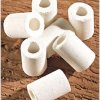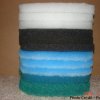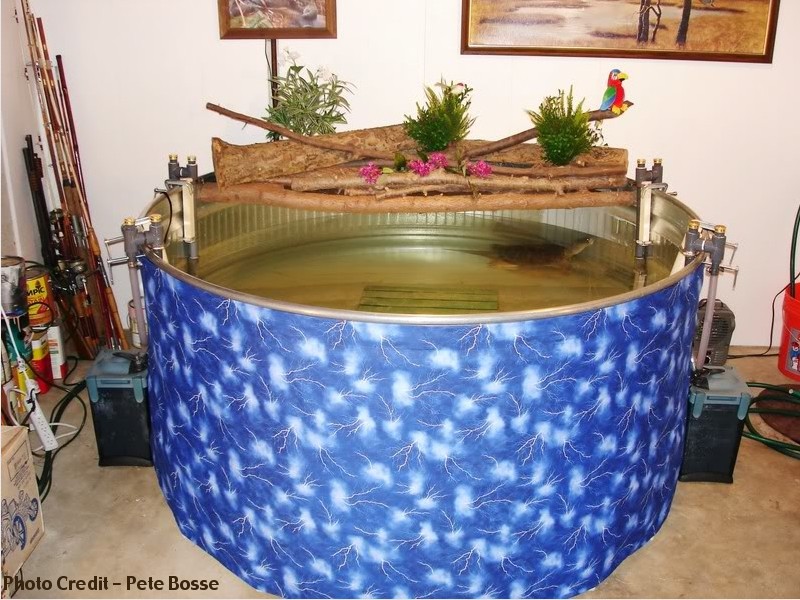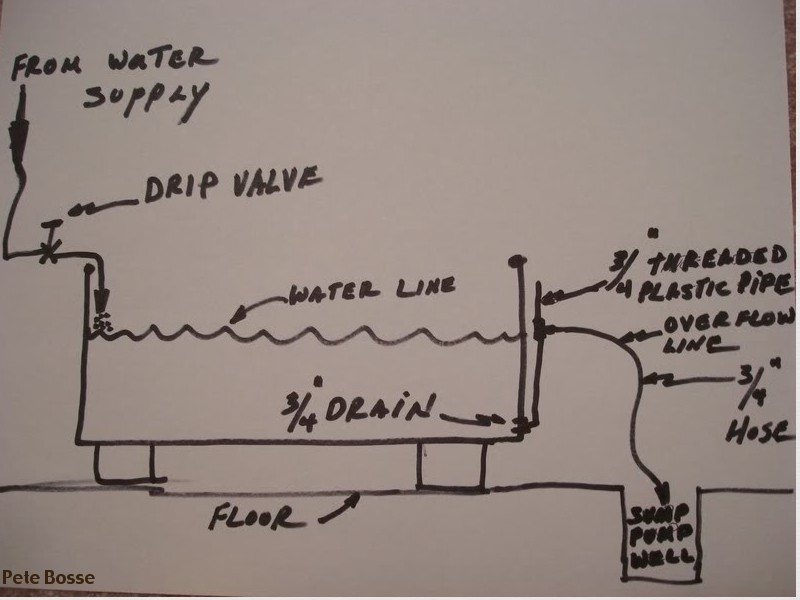Pete, a special guest of theTurtleRoom, shares his experience and knowledge in filter engineering to help you build a quality filtration system.
One of the most important parts of keeping your turtle healthy and happy is a good filtration system. I like to take the balanced approach. In a balanced filtration system, we must look at every part. Filtration systems consist of a filter, different type media for mechanical, biological, and chemical filtration, and water volume. What we are trying to do is balance each component of a filtration system with the waste load. The waste load is one of the most important aspects of a filtration system; determined by the number and size of turtles in your water system.
So, let’s take the number and size of your turtles and determine the necessary water volume. The water volume helps dilute the waste and reduces the load on the filter(s). Your turtle(s) requires a certain amount of water to remain healthy and happy. A preferred general guideline to determine the water volume required for your turtle(s) can be calculated by adding the length of the largest turtle’s shell to one half the shell length of any additional turtles multiplied by ten gallons. For example, if you have three turtles that are 6″, 4″, and 2″, you would add the largest turtle of 6″ to one half the shell length of the 4″ and 2″ turtles. Or 6″ plus 4″/2 plus 2″/2 which equals 9″, times the 10 gallons equals 90 gallons of water required for your group of three turtles. A tank to accommodate 90 gallons will be necessary. Consider an above tank basking area to keep the tank size to a minimum.
Once we have determined the water volume needed, a filter powerful enough to circulate the tank water volume 2.5 times an hour, plus adequate media storage capacity inside the filter, is necessary to keep the water clean and healthy for your turtle(s). Most manufacturers list the motor flow rate in gallons per hour (gph). This rate can be very deceiving because it is not the true circulation rate of the filter under normal operating conditions. In order to determine the true circulation rate of a filter, one can multiply the motor flow rate by sixty five percent (0.65). Some manufacturers do list the circulation rate, which is the rate at which the filter can pump the water with all media and hoses installed and working under normal operating conditions. For example, if you are using 90 gallons of water in your tank, then the filter(s) should have a circulation rate of 90 gallons times 2.5 or 225 gph. Many filter manufacturers list the filter capacity in gallons of water that it can filter. This recommendation might be accurate for a fish tank, but for turtles, the value should be reduced to half. In other words, if the filter rating capacity is for 200 gallons, then for turtles it should be 100 gallons of filtering capacity.
Now that we have determined the balance between the waste load, water volume, and filter size, let us look at each type of filtration necessary to maintain a balanced system. There has to be a certain amount of mechanical media to handle the waste load. Generally, a canister filter that holds around two gallons of water is good for most tank systems.  That size filter should easily filter 100 gallon of water and keep it clean for at least one month. One month between filter cleaning is a good goal. Longer would be even better. A filter like the Rena XP-L (aka-XP3) or a Fluval 406 can accomplish that.
That size filter should easily filter 100 gallon of water and keep it clean for at least one month. One month between filter cleaning is a good goal. Longer would be even better. A filter like the Rena XP-L (aka-XP3) or a Fluval 406 can accomplish that.
 Next, let us look at biological filtration, which is very important. It can lower tank water toxins to safe levels. Generally, a one liter box of bio-media is enough to support a colony of nitrifying bacteria to keep the ammonia and nitrite at zero, while the nitrate increase over time depending on the waste load. Chemical filtration can play a key role if you want to remove traces of smell that many times are a result of dissolved waste matter. Once the waste dissolves into the water, only carbon (activated charcoal) can remove it.
Next, let us look at biological filtration, which is very important. It can lower tank water toxins to safe levels. Generally, a one liter box of bio-media is enough to support a colony of nitrifying bacteria to keep the ammonia and nitrite at zero, while the nitrate increase over time depending on the waste load. Chemical filtration can play a key role if you want to remove traces of smell that many times are a result of dissolved waste matter. Once the waste dissolves into the water, only carbon (activated charcoal) can remove it.
Now we are at a point where we must get each type of filtration in balance with the waste load. The reason we need to do this is because each type of filtration must be set up in such a way that it will function properly. If it isn’t, the tank water could fowl and make your turtle sick. Chemical filtration with the use of carbon is not always necessary. If you can collect the waste mechanically before it dissolved in the water, there shouldn’t be any smell.
 To balance the biological part of the filtration system, we must follow these steps to establish a colony of nitrifying bacteria. The process is known as “cycling the tank”. The procedure is to introduce some sort of organic waste, usually from the turtle, to get the process started. Once the organic waste begins to decay by bacteria, it is converted to ammonia. Nitrifying bacteria further convert the ammonia into nitrite and finally into nitrate. In order to get the nitrifying bacteria in balance with the waste load, one must follow the procedure of allowing the ammonia and nitrite to build up to 3-4ppm during the cycle period. Fifty-percent (50%) water changes during this time keep the toxins at a low level and continue the colonization of nitrifying bacteria on the bio-media. Once the ammonia and nitrite remain at zero, the biological filtration is said to be in balance with the waste load.
To balance the biological part of the filtration system, we must follow these steps to establish a colony of nitrifying bacteria. The process is known as “cycling the tank”. The procedure is to introduce some sort of organic waste, usually from the turtle, to get the process started. Once the organic waste begins to decay by bacteria, it is converted to ammonia. Nitrifying bacteria further convert the ammonia into nitrite and finally into nitrate. In order to get the nitrifying bacteria in balance with the waste load, one must follow the procedure of allowing the ammonia and nitrite to build up to 3-4ppm during the cycle period. Fifty-percent (50%) water changes during this time keep the toxins at a low level and continue the colonization of nitrifying bacteria on the bio-media. Once the ammonia and nitrite remain at zero, the biological filtration is said to be in balance with the waste load.
To completely balance the nitrogen cycle, one must not forget about the byproduct of this cycle, which is nitrate. Remember, the decomposing bacteria convert the organic waste into ammonia and then the two nitrifying bacteria further convert the ammonia into nitrite then into nitrate, which keep increasing over time depending on the waste load. So in order to get the complete nitrogen cycle in balance, I set up an automatic fresh water drip system. This system drips 30% of the tank’s water volume into the water system per day. The drip system not only does automatic water changes, but keeps the nitrate below 20ppm. It also compensates for evaporated water, keeping the waterline stable. If you’re wondering if the fresh water used in the drip system contains chlorine, yes, it has about 1.5ppm of chlorine. But, that doesn’t matter because, as the nitrifying bacteria age, it forms a biofilm that protects the bacteria from chlorine. Therefore, the nitrifying bacteria remain very stable. Now the complete biological system is in balance. (Obviously, a drip system is not a realistic goal for many keepers. However, this paragraph explains why water changes are a part of the complete, balanced, filtration system.)
Finally, we must get the mechanical part of the filtration system in balance with the waste load. What this means is that the proper media is used in the filter(s) where each pore size sponge and floss media all fill up (with waste) at the same rate. This to me is most difficult to accomplish of the three type of filtration. It takes trial and error to achieve this balance. I recommend at least three different pore size sponges, including filter floss at the tail end of the media setup. Usually, one very coarse sponge is sufficient to start out with. It serves as a prefilter for the rest of the media stack. Then some coarse, medium and fine sponges follow. Filter floss is also recommended. Depending on the volume of the filter, a couple coarse sponges, followed by two or three medium and fine sponges, followed by at least three filter floss pads (four pads would be even better). The more floss pads used, the longer it takes to fill them with waste. Filter sponges have passageways through them called pores. They come in different sizes and collect a different size of waste. It’s important to start with the coarsest sponges first as the water flows, otherwise the fine sponges would clog too quickly. Filter floss is made a little different than sponges. While sponges have passageways through them, filter floss is constructed of woven strands of fiber that collect the finest of waste particles. Filter floss helps prevent the very fine waste from reentering the tank water as it passes through the filter. This retention of the very fine waste helps reduce tank water smell.
It’s important to start with the coarsest sponges first as the water flows, otherwise the fine sponges would clog too quickly. Filter floss is made a little different than sponges. While sponges have passageways through them, filter floss is constructed of woven strands of fiber that collect the finest of waste particles. Filter floss helps prevent the very fine waste from reentering the tank water as it passes through the filter. This retention of the very fine waste helps reduce tank water smell.
The filter media is said to be in balance with the waste load when each pore size media fills up with waste at the same rate. Not any set of media, including the filter floss, gets filled up any sooner than the other. If you notice upon cleaning the filter media, the floss filling up too soon while the rest of the media is only half full, then add another pad or two to the floss. If the fine pore sponges are filling up too fast as compared to the medium pore sponges. Then just remove one medium pore sponge and add another fine pore sponge. This should balance out the stack of media. Again, the goal is to have each media pore size fill up at the same rate so filter cleaning is extended as long as possible. When each of the components of the filtration system is in balance with the waste load, then you have achieved the complete, balanced, filtration system. This system was developed filtering my 66 lb common snapper. It works very well. Good luck and happy filtering.







I just stumbled upon this post, and found it to be extremely well written and interesting. So much so that it made me sign up for the site just so I say how fantastic this post is. I’m excited to try to set up a drip system of my own–an idea that has in the past crossed my mind, but until now didn’t seem feasible. Thank you!
Jon,
Glad you enjoyed the article. The drip system can save you a lot of time and effort. It also helps out the filtrations system. If set low enough, like I have, the low rate of the drip isn’t recorded on the water meter. It’s called meter slippage. Granted, some of this free water is already part of your bill I suspect. Good luck!
Pete (aka, CLAWS)
Just the kind of information I was looking for! Thank you Claws! (and Anthony for pushing me this way!)
Hi claws. I would like to chat with you about filters for turtle ponds. Can you please email me at [email protected]
Thanks Richard
Hi Pete. I got confused and I email some questions about filtration to Steve. How can I reach you via email?
gmartine
Just post your questions here and I will be glad to respond.
Hi Pete,
My question was already answered by Steve. I am a Rena XP4 filter and it clogged after less than 2 weeks working. I use only one of the fine filter pad on the top basket. It seems it is not necessary to use either filter floss or fine filter pads to get a good quality water. Do you recommend using any water conditioners? The water in my house is really hard. It has a lot of minerals.
Hi,
Most filters these days come with just one floss pad. The pad is designed for use with fish. It’s too fine for use with turtles. With my 72lb. snapper, I use 4-filter floss pads. There best in the last basket on top. I recommend the filter floss by Big Als, http://www.bigalspets.com/filter-floss-20-sq-ft.html just cut to size. It’s also sold on amazon. The floss isn’t as fine as what comes with the filter. If you use 4-pads, it takes four times as long to fill with waste. It also comes in 10-sq-ft. rolls.
You can try without the floss, but I think you will be surprised how crystal clear your water will be with four pads. If that fine floss pad clogged in 2-weeks, Big Als floss should last at least 3-months with 4-pads and your present waste load.
Let us know what you fine with and without the floss pads. Happy filtering.
Pete
Hi Pete,
It doesn’t hurt to try the floss and give it a shot. It is not too expensive.
Would you recommend any additional water treatment for my water? Do you recommend using any water conditioners? The water in my house is really hard. It has a lot of minerals.
Hi,
The only water conditioner I would recommend is to remove the chlorine. Not the one’s that also remove ammonia. Let the nitrifying bacteria do that. http://www.bigalspets.com/tap-water-conditioner-16-fl-oz.html
For the hard water, which don’t harm the turtles, I would just use a single edged razor blade with holder and wet the waterline in the aquarium to prevent scratching and remove the buildup that way. Good luck!
-Pete
Hi Pete
I have a rena xp4. I have read you recommend to use a powerhead for oxygenation purpose and to remove protein build up from the top of the aquarium. I have been agitating the top my turtle tank with the outlet of my filter. I have only one turtle (10 yrs old RES). Is if necessary to use a powerhead? Any recommendation? My tank size is 75G
Hi,
With my large snapper, I use three rena XP3’s. Three inlets and two outlets are at the bottom of the tank where most of the heavier waste settles to. One outlet is at the surface for agitation and aeration. With just one filter, I think you get better filtration with both inlet and outlet at the bottom of the tank and a power-head at the surface. That way you have the thrust power of the outlet of the filter at the bottom of the tank where it can due a better job of filtering. But, a second filter with outlet at the surface and inlet at the bottom would be even better. Or even a second filter and a power-head would be better yet, especially with a larger tank of 75G.
-Pete
Hi Pete
For budget reasons I will have to stick to just one filter. Any recommendation or suggestion for the brand and the specifications of the powerhead?
Thank you for your assistance
Hi,
Just about any brand at a reasonable price will do. For your size aquarium something in the range of 250-300gph should be fine. Something like this would be a possibility.
http://www.amazon.com/JEBO-AP1500-Aquarium-Power-290GPH/dp/B00EQ6MAQG/ref=sr_1_25?ie=UTF8&qid=1409894955&sr=8-25&keywords=powerheads+for+aquarium
Hi Pete,
Thank you for your wise insight. I am thinking about getting the following one (rated a 425gph)
http://www.amazon.com/Hydor-Koralia-Nano-Aquarium-Circulation/dp/B0036S70ZG
Reasons:
1. It seems to be a little bit better constructed.
2. It is installed using a powerful magnet instead of suction cups.
3. It is only 3 dollars extra 🙂
4. It consumes less power. 3.5W vs 18W the Jebo consumes.
Your thoughts?
Hi Pete,
Thank you for your wise insight. I am thinking about getting the following one (rated a 425gph)
http://www.amazon.com/Hydor-Koralia-Nano-Aquarium-Circulation/dp/B0036S70ZG
Reasons:
1. It seems to be a little bit better constructed.
2. It is installed using a powerful magnet instead of suction cups.
3. It is only 11 dollars extra 🙂
4. It consumes less power. 3.5W vs 18W the Jebo consumes.
Your thoughts?
Hi,
Actually, any type pump that agitates the surface will help keep the scum buildup under control. What you are talking above is basically a circulation pump. This type is great for eliminating dead spots in larger tanks like yours and general water movement for better filtration. Circulation pumps can also be used to agitate the surface of the tank water. If placed too close to the surface it can suck in air that can cause cavitation of the propeller.
Power-heads are designed to have the outlet flow right at the waterline. They also have an air attachment to regulate the amount of air injected into the water. I’m not sure the circulation pump agitates the surface water enough to aerate the water much.
In my snapper tank, the outlet of one of my XP3’s is set right at the surface of the water for max agitation, so it not only mixes the surface water but also adds air as well.
You can go on youtube.com and watch a number of vid’s on all kinds of pumps. Power-heads and circulation pumps and the like. That will give you a better idea how they work.
Pete
Pete,
I ended up getting a cobalt aquatics powerhead:
http://www.amazon.com/Cobalt-Aquatics-Power-Head-MJ1200/dp/B005QRHEJW/ref=cm_sw_em_r_awd_.FKeub0FXH1GR_tt
It was about $29 with 3 years warranty and made in Italy 😉
How far should the powerhead be from the water like ?
Your insights are appreciated
Hi,
Looks like a very good, high quality power head pump. Very good review here, and a very quiet pump.
http://www.youtube.com/watch?v=5KeAxahAXGY Can be adapted to other devices as shown in the vid.
It depends on what you want to do with it for it’s placement. This power head has the air intake adjustment, where you can inject air into the water while pointing the outlet towards the bottom of the tank on just about any angle.
If to want max surface agitation, I would place the outlet horizontal right at the surface of the water where the stream of water moves the water the most. Surface adjustment might be necessary because of water noise if tank is in a sleeping or other quiet area.
If you have some dead spots at the bottom of the tank the power head can also be used for water circulation if scum buildup at the surface isn’t a problem. You should be happy with the pump because of it versatility.
Pete
Yes. I am really happy with the powerhead. Thanks for you wisdom. I had a question closely related to filtration. What are your thoughts about substrate? I have a bare bottom (less maintenance) but it looks a little boring. People have recommended me to use sand and someone mentioned aragonite. It seems aragonite could really mess things up. Your thoughts?
Pingback: The Best Filter For Turtle Tanks: The Top 7 of 2019 - Pet So Fun